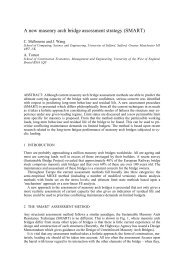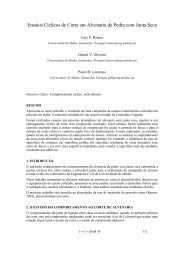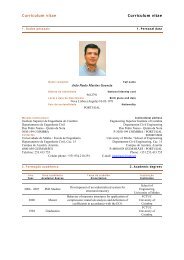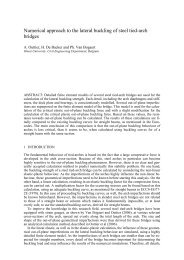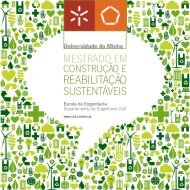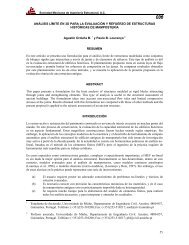Sustainable Construction A Life Cycle Approach in Engineering
Sustainable Construction A Life Cycle Approach in Engineering
Sustainable Construction A Life Cycle Approach in Engineering
You also want an ePaper? Increase the reach of your titles
YUMPU automatically turns print PDFs into web optimized ePapers that Google loves.
Figure 17: Toughness Index – Effect of fibre type<br />
Effect of fibre volume<br />
Figure 16 <strong>in</strong>dicates an <strong>in</strong>crease <strong>in</strong> toughness with <strong>in</strong>creased volume fraction, for the various fibres<br />
used. The <strong>in</strong>creases <strong>in</strong> toughness with volume fraction, is attributed to the <strong>in</strong>crease <strong>in</strong> the<br />
fibres <strong>in</strong> the matrix and across cracks.<br />
Effect of fibre type<br />
A representation of the toughness <strong>in</strong>dexes of the various test specimens for vary<strong>in</strong>g volume fraction<br />
is given <strong>in</strong> Fig. 17. Trends attributed to fibre geometry can be observed. For all volume<br />
fractions, IFCA (hooked ended fibres, l/d: 79) mixes demonstrated the highest toughness. This<br />
was followed by TFRC (shredded tyre fibres, l/d: 132) and IFCB (hooked ended fibres, l/d: 50)<br />
mixes. IFCC (crimped fibres, l/d: 50) mixes exhibited the lowest level of toughness.<br />
In compar<strong>in</strong>g fibre profiles, hooked ended fibres (IFCA, IFCB) <strong>in</strong>dicated higher toughness<br />
than crimped fibres (IFCC). Shredded tyre fibres showed higher levels of toughness than<br />
crimped fibres, and hooked ended fibres with an aspect ratio of 50. The profile of shredded tyre<br />
fibres is rather random and non-uniform. The twisted nature of the shredded fibres potentially<br />
contributes for enhanced anchorage and bond<strong>in</strong>g with the matrix.<br />
In compar<strong>in</strong>g IFCA (hooked ended fibres, l/d: 79) and IFCB (hooked ended fibres, l/d: 50),<br />
an <strong>in</strong>crease <strong>in</strong> aspect ratio resulted <strong>in</strong> <strong>in</strong>creased toughness.<br />
4 CONCLUSIONS<br />
For the various types of fibres used <strong>in</strong> the mixes, the addition of fibres to the matrix resulted <strong>in</strong><br />
<strong>in</strong>creased compressive strength. The ga<strong>in</strong> <strong>in</strong> strength <strong>in</strong> general <strong>in</strong>creased as the volume fraction<br />
of the fibres added was <strong>in</strong>creased. However the strength obta<strong>in</strong>ed for TFRC-2.0, was lower than<br />
the strength obta<strong>in</strong>ed for TFRC-1.5. The highest strengths were obta<strong>in</strong>ed for IFCA mixes (Dramix<br />
RC-80/30-BP) for volume fractions 1.0% and 2.0%. This was attributed to the aspect ratio<br />
of these fibres, which was significantly higher than the aspect ratio of the other fibres.<br />
Flexural tensile strength tests for all mixes <strong>in</strong>dicate that the addition of fibres to the fresh mix<br />
<strong>in</strong>creased the ductility of the composite <strong>in</strong> the hardened stage. An <strong>in</strong>crease <strong>in</strong> peak strength was<br />
also recorded. Failure of all specimens was due to fibre slippage rather than yield<strong>in</strong>g of the fibre<br />
re<strong>in</strong>forcement.<br />
87



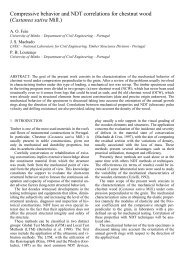
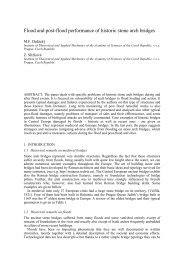
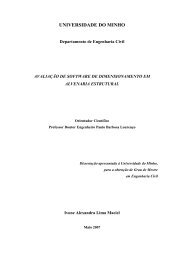
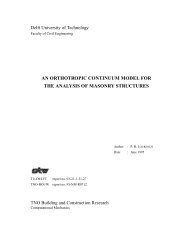

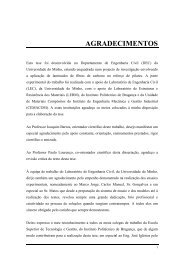

![Weibull [Compatibility Mode]](https://img.yumpu.com/48296360/1/190x134/weibull-compatibility-mode.jpg?quality=85)

